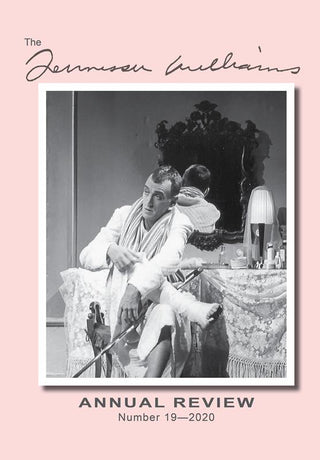The Tennessee Williams Annual Review 2020
published by The Historic New Orleans Collection
softcover • 6" × 9" • 154 pp.
1 color image, 8 b/w images
ISSN 1097-6035 / ISBN 978-0-917860-84-3
Founded in 1998, the Tennessee Williams Annual Review remains the only regularly published journal devoted to Tennessee Williams’s works, influence, material history, and cultural context. The journal includes scholarship on a wide range of topics, including Williams’s plays, prose, and poems, as well as productions and film adaptations of his works. Many issues also showcase a previously unpublished work from the Williams archive. Past issues of the Review are also available in electronic format at WWW.TENNESSEEWILLIAMSSTUDIES.ORG .
The 2020 issue sees the first-ever publication of Williams’s tense short story “Why Did Desdemona Love the Moor?”—possibly too controversial to publish during his lifetime and previously accessible only in archived fragments. Inside, essays treat readers to rare images of Ingmar Bergman’s 1950s staging of Cat on a Hot Tin Roof, moving fan letters written to the playwright during his lifetime, and a reconstruction of the long-lost musical soundscape Paul Bowles composed for Sweet Bird of Youth.
published by The Historic New Orleans Collection
softcover • 6" × 9" • 154 pp.
1 color image, 8 b/w images
ISSN 1097-6035 / ISBN 978-0-917860-84-3
Founded in 1998, the Tennessee Williams Annual Review remains the only regularly published journal devoted to Tennessee Williams’s works, influence, material history, and cultural context. The journal includes scholarship on a wide range of topics, including Williams’s plays, prose, and poems, as well as productions and film adaptations of his works. Many issues also showcase a previously unpublished work from the Williams archive. Past issues of the Review are also available in electronic format at WWW.TENNESSEEWILLIAMSSTUDIES.ORG .
The 2020 issue sees the first-ever publication of Williams’s tense short story “Why Did Desdemona Love the Moor?”—possibly too controversial to publish during his lifetime and previously accessible only in archived fragments. Inside, essays treat readers to rare images of Ingmar Bergman’s 1950s staging of Cat on a Hot Tin Roof, moving fan letters written to the playwright during his lifetime, and a reconstruction of the long-lost musical soundscape Paul Bowles composed for Sweet Bird of Youth.
The Tennessee Williams Annual Review 2020
published by The Historic New Orleans Collection
softcover • 6" × 9" • 154 pp.
1 color image, 8 b/w images
ISSN 1097-6035 / ISBN 978-0-917860-84-3
Founded in 1998, the Tennessee Williams Annual Review remains the only regularly published journal devoted to Tennessee Williams’s works, influence, material history, and cultural context. The journal includes scholarship on a wide range of topics, including Williams’s plays, prose, and poems, as well as productions and film adaptations of his works. Many issues also showcase a previously unpublished work from the Williams archive. Past issues of the Review are also available in electronic format at WWW.TENNESSEEWILLIAMSSTUDIES.ORG .
The 2020 issue sees the first-ever publication of Williams’s tense short story “Why Did Desdemona Love the Moor?”—possibly too controversial to publish during his lifetime and previously accessible only in archived fragments. Inside, essays treat readers to rare images of Ingmar Bergman’s 1950s staging of Cat on a Hot Tin Roof, moving fan letters written to the playwright during his lifetime, and a reconstruction of the long-lost musical soundscape Paul Bowles composed for Sweet Bird of Youth.
published by The Historic New Orleans Collection
softcover • 6" × 9" • 154 pp.
1 color image, 8 b/w images
ISSN 1097-6035 / ISBN 978-0-917860-84-3
Founded in 1998, the Tennessee Williams Annual Review remains the only regularly published journal devoted to Tennessee Williams’s works, influence, material history, and cultural context. The journal includes scholarship on a wide range of topics, including Williams’s plays, prose, and poems, as well as productions and film adaptations of his works. Many issues also showcase a previously unpublished work from the Williams archive. Past issues of the Review are also available in electronic format at WWW.TENNESSEEWILLIAMSSTUDIES.ORG .
The 2020 issue sees the first-ever publication of Williams’s tense short story “Why Did Desdemona Love the Moor?”—possibly too controversial to publish during his lifetime and previously accessible only in archived fragments. Inside, essays treat readers to rare images of Ingmar Bergman’s 1950s staging of Cat on a Hot Tin Roof, moving fan letters written to the playwright during his lifetime, and a reconstruction of the long-lost musical soundscape Paul Bowles composed for Sweet Bird of Youth.
